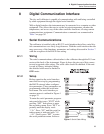
9 Test Probe Calibration
For optimum accuracy and stability, allow the calibrator to warm up for 10
minutes after power-up and then allow adequate stabilization time after reach
-
ing the set-point temperature. After completing operation of the calibrator, al
-
low the well to cool by setting the temperature to 100°C for one-half hour
before switching the power off.
9.1 Comparison Methods
For information on automating your testing, contact Hart Scientific.
9.1.1 Calibrating a Single Probe
Insert the probe to be calibrated into the well of the dry-well calibrator. The
probe should fit snugly into the calibrator probe sleeve yet should not be so
tight that it cannot be easily removed. Avoid any dirt or grit that may cause the
probe to jam into the sleeve. Best results are obtained with the probe inserted to
the full depth of the well. Once the probe is inserted into the well, allow ade-
quate stabilization time to allow the test probe temperature to settle as de-
scribed above. Once the probe has settled to the temperature of the well, it may
be compared to the calibrator display temperature. The display temperature
should be stable to within 0.1°C degree for best results.
CAUTION: Never introduce any foreign material into the probe hole of
the insert. Fluids etc. can leak into the calibrator causing damage to the
calibrator or binding and damage to your probe.
9.1.2 Comparison Calibration
Comparison calibration involves testing a probe against a similar reference
probe. The advantage to this method is that better accuracy can be achieved
since errors due to dry-well inaccuracy, stem effect, and drift can be reduced.
After inserting the probes to be calibrated, allow sufficient time for the probes
to settle and the temperature of the dry-well to stabilize.
Both the reference probe and the probe under test should be the same size and
construction. Using probes with different lengths, diameters and materials will
have different stem effects causing an unknown temperature difference. All
dry-wells have horizontal and vertical gradients that change with temperature .
This is an unknown variable which can be factored out if probes are the same
type, length, diameter, and material. Probes should be inserted to the same
depth in the well.
The following procedure can be used to calibrate a probe against a reference
while eliminating error due to temperature gradients between wells.
1. Place the reference probe in one well.
39
9 Test Probe Calibration
Comparison Methods


















